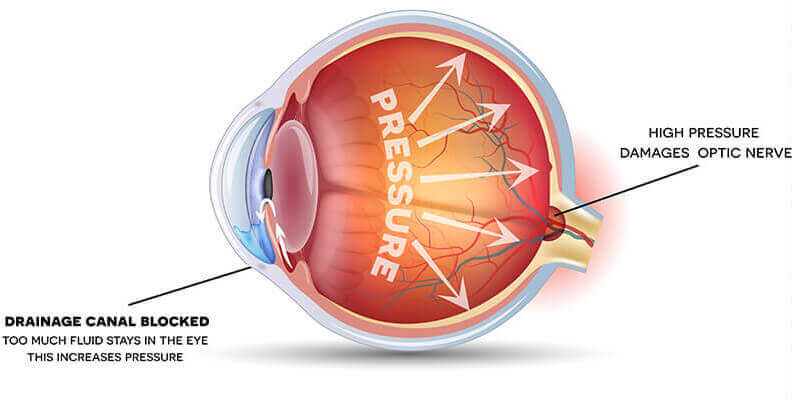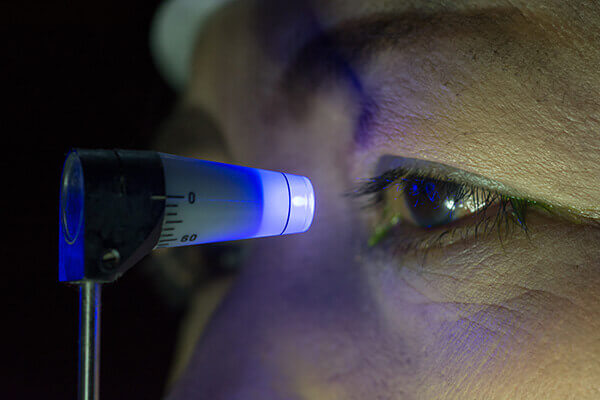Glaucoma

Glaucoma is one of the leading causes of blindness in adults who are 60 and older. Having glaucoma doesn’t have to mean the end of your ability to see. The caring team at Kresloff Eye Associates is dedicated to caring for patients with many eye conditions, including glaucoma.
What is Glaucoma?
Glaucoma refers to a group of eye conditions that damages the optic nerve. The optic nerve is part of the eye responsible for taking the nerve signals sent from the eye and translating them into images the brain can understand.
Any damage to the optic nerve is irreversible and permanent. For patients with glaucoma, it causes vision loss and even blindness if left untreated.
The most common reason patients develop glaucoma is high intraocular pressure (IOP). IOP is usually elevated in glaucoma patients, although it is also possible to have higher than normal intraocular levels without a diagnosis.
There are many kinds of glaucoma
The two most common are: open-angle and angle-closure:
Open-Angle Glaucoma
Open-angle glaucoma is by far the most common kind of glaucoma that most patients are diagnosed with having. Open-angle glaucoma takes a long time to develop, with most patients not realizing they have it until vision loss has already occurred.
By this time, it’s too late and irreversible. It occurs when the eye’s drainage canals become blocked, preventing it from draining the proper amount of fluid. As a result, intraocular pressure levels rise, causing open-angle glaucoma.
Angle-Closure Glaucoma
Another kind of glaucoma, although rare, is angle-closure. Angle-closure glaucoma, unlike open-angle, does not occur slowly over time.
Instead, it happens quickly and is considered a medical emergency. During angle-closure glaucoma, the iris is narrower and not as open as it should be. As a result, the eye’s drainage canals get blocked or covered, rapidly increasing intraocular pressure in patients. It must be treated immediately to avoid permanent loss of vision.
Are There Signs or Symptoms of Glaucoma?
There are few discernible signs or symptoms of glaucoma. It is often called the secret thief of sight because most patients don’t realize they have the vision-stealing eye condition until permanent vision loss has occurred.

In open-angle glaucoma, symptoms may include:
- Gradually losing your peripheral vision
- Seeing more halos around lights
- Noticing your eyes look red
- Having more headaches
- Blurry vision
Most patients may not notice these symptoms immediately or associate them with other age-related eye conditions like presbyopia or cataracts.
Symptoms with angle-closure glaucoma are far different and come on suddenly, including:
- Severe, sudden eye pain
- Headache
- Nausea or vomiting
- Sudden loss of vision
- Redness in the eyes
If you suspect angle-closure glaucoma, inform your ophthalmologist immediately and get medical attention. Patients can suffer permanent vision loss if angle-closure glaucoma is not promptly treated.
Risk Factors for Developing Glaucoma
Certain things may increase your risk of developing glaucoma. These include:
Family History of Having Glaucoma
If you have family members you know with glaucoma, your risk of developing the eye condition will increase. Let your eye doctor know; they may want you to come in for more frequent eye exams.
Being Over the Age of 60
Adults over 60 have an increased risk of developing age-related eye conditions like glaucoma. This is the age when you’re more likely to start seeing changes to your vision, so your eye doctor will likely want you to come in for an eye exam at least once a year.
Certain Medical Conditions
Patients with certain medical conditions like diabetes or high blood pressure are at an increased risk of developing glaucoma. Your eye doctor may recommend more regular eye exams to monitor your eyes for signs of glaucoma or other eye conditions.
Being of African, Asian, or Hispanic Descent
Some ethnic communities, including those of African, Asian, or Hispanic descent, have an increased risk of developing glaucoma. For example, you’re predisposed to thinner corneas if you’re an African American or Latino.
Most eye doctors prefer a proactive approach and recommend more frequent eye exams to monitor these patients for early signs of glaucoma.
Taking Medications like Steroids
Although it may be necessary, taking certain medications like corticosteroids may increase your risk of glaucoma. Tell your ophthalmologist about all your medications, including corticosteroids, and how long you’ve been taking them.
They may want to see you more to ensure they can monitor you closely.
When to See Your Eye Doctor
Glaucoma usually has no symptoms, so it’s essential to stay up to date on eye exams. At the very least, patients should see their ophthalmologist for an eye exam once a year after turning forty.
This is when your risk of developing age-related eye conditions like glaucoma increases. If you’re at high risk for glaucoma due to other factors, your eye doctor may recommend a more frequent schedule, which they will review with you.
See your eye doctor as soon as possible if you notice new changes to your vision, sudden eye pain, or other symptoms associated with angle-closure glaucoma.
Diagnosing Glaucoma

If your ophthalmologist suspects you have glaucoma, they will use several tests to diagnose it. These are conducted during a comprehensive eye exam and include:
Examining the Optic Nerve
Your eye doctor will examine your optic nerve to see any signs of damage. Although you can’t see any signs of damage to the optic nerve, your eye doctor can use imaging tests like optical coherence tomography (OCT) or visual field testing.
Tonometry
One sign of glaucoma is increased intraocular pressure. Tonometry is a test that measures the pressure inside your eye with a special instrument called a tonometer that touches the surface of your eye.
Gonioscopy
During gonioscopy, your ophthalmologist will use a lens that allows them to examine the eye’s drainage angle. This information helps them determine if the angle is open or shut, which helps with understanding if it’s open-angle glaucoma or a different form.
If you think you may have glaucoma, the experienced team at Kresloff Eye Associates is here to assess, diagnose, and treat this eye condition to ensure the best outcome for your eyes. Schedule an appointment at Kresloff Eye Associates in Collingswood, NJ, today!
